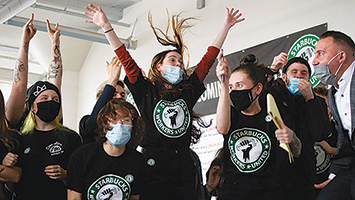The problem is outdated Labor laws
By TIM ROWDEN
Managing Editor

Approval of unions and interest in organizing is higher than it has been in decades, but new data on unionization from the Bureau of Labor Statistics (BLS) shows that, statistically, union membership declined last year. How can that be?
Heidi Shierholz, president of the Economic Policy Institute, explained the numbers in a Jan. 20 online press conference with local and national Labor journalists.
Unionization rates jumped by half a percentage point in 2020, from 11.6 percent to 12.1 percent, Shierholz said, due largely to a “pandemic composition effect” — the fact that the majority of jobs lost to the pandemic in 2020 were more concentrated in industries with low unionization rates, such as leisure and hospitality. That pandemic composition effect began to unwind in 2021, she said. Non-unionized jobs began returning, tilting the overall percentage of non-unionized workers in the workforce back in the other direction, even with high union approval rates and a growing number of workers fighting to organize their workplaces.
“The 2021 union numbers are a real wake-up call,” Shierholz said. “As we rebuild our economy, it is crucial that the Biden Administration and Congress institute policies like the Protecting the Right to Organize (PRO) Act, the Public Service Freedom to Negotiate Act – policies that promote the right to union representation and collective bargaining. And I will say, if policymakers fail to act, the downward trends in unionization will continue and the post-pandemic economy will be marked by widespread inequality and wage stagnation for working people, so the stakes are really high.
“The substantial level of union activity in 2021 and the polling data of union favorability demonstrates that workers want unions, workers value unions, but the fact that unionization still declined is a massive testament to how broken our Labor law is,” she said.
Labor shortages during the pandemic have given workers an edge in demanding better wages, leaving bad jobs and organizing, Shierholz said, but that edge is unlikely to last without substantial changes to the nation’s outdated Labor law.
“The American Rescue Plan Act has generated an incredibly strong recovery with huge demand for workers. At the same time millions of workers are out of the labor force due to health and safety concerns or Covid-related care responsibilities. So there’s a lot of demand for workers and fewer workers around,” Shierholz said.
“Employers have had to compete for workers, and that means that workers have more power, but these dynamics are unlikely to continue once the pandemic is behind us. For lasting worker power, for lasting strong wage growth and decent working conditions going forward, working people absolutely have to be able to join unions.”
PROTECTING THE RIGHT TO ORGANIZE
The Protecting the Right to Organize (PRO) Act, which passed the House last year with bipartisan support, provides a comprehensive set of reforms that would strengthen private-sector workers’ right to form a union and engage in collective bargaining.
 “The decline of union membership in 2021 is a wake-up call to lawmakers that we must reform our broken Labor law,” said Shierholz. “The Biden administration and Congress must adopt policies that make it easier for workers to form a union, including the PRO Act. Not only are these policy changes crucial to restoring a fair balance of power between workers and employers, they are also essential to an equitable recovery from the coronavirus pandemic.”
“The decline of union membership in 2021 is a wake-up call to lawmakers that we must reform our broken Labor law,” said Shierholz. “The Biden administration and Congress must adopt policies that make it easier for workers to form a union, including the PRO Act. Not only are these policy changes crucial to restoring a fair balance of power between workers and employers, they are also essential to an equitable recovery from the coronavirus pandemic.”
The number of workers in unions dropped in 2021 by 137,000, on top of a decline of 444,000 in 2020, for a total reduction of 581,000 union workers between 2019 and 2021. The unionization rate held steady between 2019 and 2021 even though the number of workers in unions dropped substantially over the same period because the number of workers in unions declined at roughly the same rate as the number of workers not in unions over this period. However, as the economy continues to recover and the pandemic composition effect continues to unwind, unionization rates will face downward pressures in 2022 — unless policymakers act to reform Labor law.
Despite the decline in union membership and the growing gap between the demand for and the availability of union membership, workers continued to exercise their right to form unions and bargain collectively in 2021.
Union activity last year included organizing drives with nurses, journalists, graduate students, and even Starbucks workers, as well as successful strikes by taxi drivers in New York, health care workers in Buffalo, and factory workers at Deere. The substantial level of union activity in 2021 demonstrates that workers want and value unions. The fact that unionization nevertheless declined is a glaring testament to how broken U.S. Labor law really is and how urgent it is that Congress pass the PRO Act and the Public Service Freedom to Negotiate Act.
Whatever business owners and policymakers may think, workers’ newly resurgent support for unions and interest in unionizing – particularly among younger workers’ – is unlikely to fade away, even after the pandemic.
“These folks have become interested in unions at a time when unionization was very, very low. So they’ve already demonstrated that they get the importance of this even in the face of extremely low unionization rates,” Shierholz said. “They are sort of jumping in with a lot of enthusiasm. The interest that they’re showing despite the low levels of unionization makes me feel like there will be some staying power there.”
Union membership numbers reflect broken Labor laws
The Bureau of Labor Statistics (BLS) annual report on union membership makes clear America’s Labor laws are broken.
While the report indicates a 0.5 percent drop in union membership from 2020–2021, the data is not representative of the greater union trends taking place across the country. The statistics highlight the urgent need for the passage of the Protecting the Right to Organize (PRO) Act and the Public Service Freedom to Negotiate Act.
BROKEN LABOR LAWS
 “In 2021, workers forcefully rejected low-wage, thankless jobs after a year of being called essential,” said AFL-CIO President Liz Shuler. “In light of the COVID-19 pandemic, it is clearer now than ever that our Labor laws are designed to make joining a union as difficult as possible. Across this country, workers are organizing for a voice on the job and millions of Americans are standing in solidarity with union members on strike. If everyone who wanted to join a union was able to do so, membership would skyrocket. The PRO Act and the Public Service Freedom to Negotiate Act are how we get there.”
“In 2021, workers forcefully rejected low-wage, thankless jobs after a year of being called essential,” said AFL-CIO President Liz Shuler. “In light of the COVID-19 pandemic, it is clearer now than ever that our Labor laws are designed to make joining a union as difficult as possible. Across this country, workers are organizing for a voice on the job and millions of Americans are standing in solidarity with union members on strike. If everyone who wanted to join a union was able to do so, membership would skyrocket. The PRO Act and the Public Service Freedom to Negotiate Act are how we get there.”
In the past year, millions of Americans have left the workforce for numerous reasons, including a lack of access to affordable child, elder and differently-abled care, as well as an unwillingness to sacrifice their health and safety for low-paying jobs with substandard benefits. Unions are the best solution to this crisis by ensuring that workers have access to safe working conditions, fair pay and health benefits, and collective bargaining rights.
COMMUNITIES OF COLOR
The BLS report also shows promising data for communities of color.
Black workers continued to have the highest unionization rate in 2021, with 12.9 percent membership. According to an Economic Policy Institute study, Black union workers are paid 13.7 percent more than their nonunionized peers.
According to a 2021 Gallup poll, union approval is at its highest level in over 50 years, with 68 percent of Americans supporting organized labor, including 77 percent of young people. An MIT study found that 60 million Americans would join a labor union if they could, underscoring the need for changes to labor laws
Latest data on unionization
One of the most important things that could be done to generate a more equitable economy is to dismantle the barriers to union organizing and collective bargaining. New data on unionization from the Bureau of Labor Statistics, coupled with evidence on the value of unions and on workers’ desire to be unionized, reinforce the importance of this goal and the urgent need for policy reforms:
• In 2021, 15.8 million workers in the United States were represented by a union—a decline of 581,000 from 2019 and well under half what it would be had the share of workers represented by a union (11.6 percent) not fallen to well under half of what it was roughly 40 years ago.
• In 2021, after shooting up to 12.1 percent in 2020 because of pandemic-related employment shifts, the unionization rate dropped back down its 2019 level of 11.6 percent (down 0.5 percentage points from 2020 to 2021).
• Unionization rates jumped up in 2020 in large part because most of the jobs lost in 2020 were in industries with traditionally low unionization rates, such as leisure and hospitality. When those jobs began to return in 2021, the apparent gains disappeared.
• Since 2019, union levels have dropped in both the private sector (down 507,000) and, to a lesser extent, in the public sector (down 74,000). In the private sector, the unionization rate in 2021 was 7.0 percent, down 0.1 percentage points from 2019. The public sector unionization rate was 37.6 percent in 2021, up 0.4 percentage points from 2019.
• The gender gap in unionization has narrowed somewhat during the pandemic. In 2021, men had a unionization rate of 11.9 percent, compared with 11.3 percent for women. However, both men and women saw declines in the number of unionized workers between 2019 and 2021 — a loss of 429,000 for men and a loss of 152,000 for women.
• Of all major racial and ethnic groups, Black workers continued to have the highest unionization rates in 2021, at 12.9 percent. This compares with 11.6 percent for white workers, 10.3 percent for Latinx workers, and 9.0 percent for Asian American/Pacific Islander (AAPI) workers.
• The substantial level of union activity in 2021 (including organizing drives and strikes), along with polling data showing the large share of workers who would like a union at their workplace, demonstrate that workers want and value unions.


